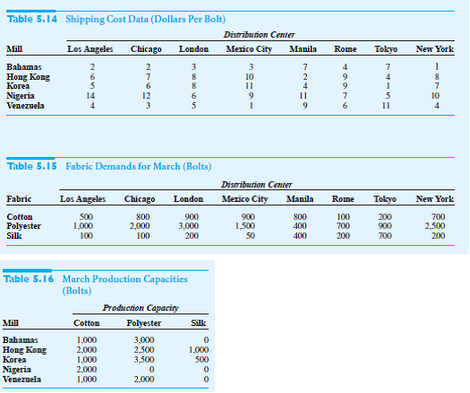International Textile Company, Ltd., is a Hong Kong?based firm that distributes textiles worldwide. The company is owned by the Lao family. Should the People's Republic
International Textile Company, Ltd., is a Hong Kong?based firm that distributes textiles worldwide. The company is owned by the Lao family. Should the People's Republic of China continue its economic renaissance, the company hopes to use its current base to expand operations to the mainland. International Textile has mills in the Bahamas, Hong Kong, Korea, Nigeria, and Venezuela, each weaving fabrics out of two or more raw fibers: cotton, polyester, and/or silk. The mills service eight company distribution centers located near the customers' geographical centers of activity.
Because transportation costs historically have been less than 10% of total expenses, management has paid little attention to extracting savings through judicious routing of shipments. Ching Lao is returning from the United States, where he has just completed his bachelor's degree in marketing. He believes that each year he can save International Textile hundreds of thousands of dollars?perhaps millions?just by better routing of fabrics from mills to distribution centers. One glaring example of poor routing is the current assignment of fabric output to the Mexico City distribution center from Nigeria instead of from Venezuela, less than a third the distance. Similarly, the Manila center now gets most of its textiles from Nigeria and Venezuela, although the mills in Hong Kong itself are much closer.
Of course, the cost of shipping a bolt of cloth does not depend on distance alone. Table 5.14 provides the actual costs supplied to Lao from company headquarters. Distribution center demands are seasonal, so a new shipment plan must be made each month. Table 5.15 provides the fabric requirements for the month of March. International Textile's mills have varying capacities for producing the various types of cloth. Table 5.16 provides the quantities that apply during March.

Lao wants to schedule production and shipments in such a way that the most costly customers are shorted when there is insufficient capacity, and the least-efficient plants operate at less than full capacity when demand falls below maximum production capacity.
You have been retained by International to assist Lao.
Lao learns that changes might have to be made to the March plans. If a new customer is obtained, the cotton demand in Manila and in Mexico City will increase by 10% at each location. Meanwhile. a big New York customer might cut back, which would reduce polyester demand by 10% in both New York and Chicago. Find the contingent optimal schedules and total costs
a. For cotton and
b. For polyester.
Table 5.14 Shipping Cost Data (Dollars Per Bolt) Mill Bahamas Hong Kong Korea Nigeria Venezuela Fabric Cotton Polyester Silk Los Angeles Mill Bahamas Hong Kong Korea 26544 Nigeria Venezuela 14 Chicago London 2 7 6 Table 5.15 Fabric Demands for March (Bolts) 12 3 Cotton 1,000 2,000 1,000 2,000 1,000 Los Angeles Chicago London 500 800 1,000 2,000 100 100 Table 5.16 March Production Capacities (Bolts) 3 8 8 6 5 900 3,000 200 Production Capacity Polyester 3,000 2,500 3,500 0 2,000 Silk 0 1,000 500 0 0 Distribution Center Mexico City Manila 3 10 11 9 1 7 2 4 900 1,500 50 11 9 Rome 800 400 400 49976 7 Distribution Center Mexico City Manila Rome 6 100 700 200 Tokyo New York 7 4 1 5 11 8 7 10 4 Tokyo New York 200 900 700 700 2,500 200
Step by Step Solution
There are 3 Steps involved in it
Step: 1
Given the details of the International Textile Company Ltd a Hong Kong based distributing firm along with the details of the shipping cost demands for the month of March and the capacities to produce ...
See step-by-step solutions with expert insights and AI powered tools for academic success
Step: 2

Step: 3

Ace Your Homework with AI
Get the answers you need in no time with our AI-driven, step-by-step assistance
Get Started


